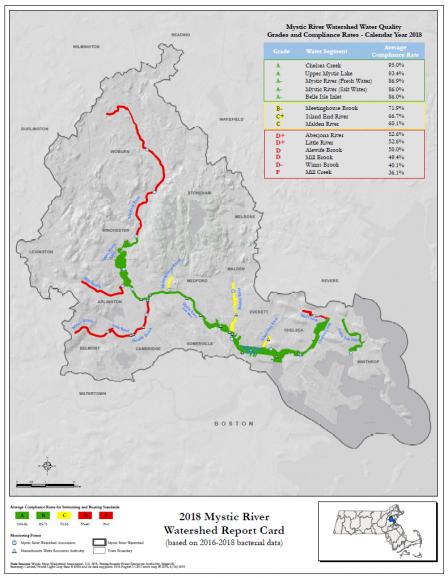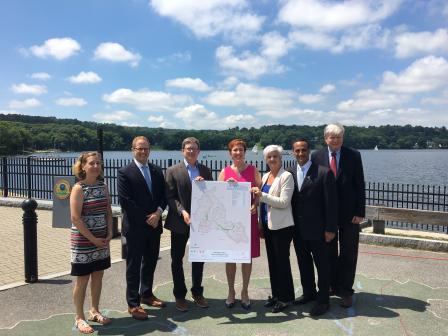News Releases from Region 01
Annual Report Card Shows Good Water Quality in Main Stem of the Mystic River in 2018
BOSTON – The U.S. Environmental Protection Agency (EPA), in collaboration with the Mystic River Watershed Association (MyRWA), announced its annual Water Quality Report Card on the Mystic River watershed for 2018. For the fifth year in a row, water quality monitoring data show that water quality in the main stem of the Mystic River, including the Upper and Lower Mystic Lakes, is very good on a regular basis and meets water quality standards nearly all the time, especially in dry weather.
"The Mystic River is a tremendous urban water resource for towns north and west of Boston," said EPA Acting Regional Administrator Deb Szaro. "Protecting the watershed is a priority for EPA. We are thrilled to see that the main stem of the Mystic and the lakes are generally in good shape, but we have work to do in the smaller streams that feed the river."
"The work of local, state and federal governments and regional advocacy groups continues to have a positive impact on water quality within the Mystic River system," said Massachusetts Department of Environmental Protection (MassDEP) Deputy Commissioner Stephanie Cooper. "We look forward to the day when the river and all of its tributaries feature clean, fresh water that supports a variety of uses."
"I encourage community members to go out and boat on the Mystic and Malden River, and swim at Shannon Beach," said Executive Director of the Mystic River Watershed Association (MyRWA) Patrick Herron. "It is a great resource--and we are so happy that it is clean and becoming even more accessible for community members with more public boat launches, canoe/kayak rental facilities, and even more connected paths and parks."
The report card gives grades to 14 segments of the Mystic River Watershed, and it shows improvement in some segments of the watershed in 2018, which indicates that work to reduce bacterial contamination may be starting to show positive changes.
While no single "overall" grade is generated for the Mystic River watershed as a whole, the data show that the main stem of the river is often safe for swimming and boating; however, bacterial levels in many of the tributary streams feeding the Mystic are high, and these areas often do not meet water quality standards. In 2018, some of these problem streams showed signs of improvement, especially Island End River in Everett and Chelsea.
"We are so lucky to have such a valuable natural resource such as the Mystic Lakes and the Mystic River in our city. It has been incredible to see the improvements in water quality over the years, demonstrating the positive impacts of the various environmental organizations and initiatives that are dedicated to the Mystic. In the next few weeks, Paddle Boston will be officially launching canoe and kayak rentals on the Mystic at the Condon Shell. We all must be stewards of this amazing environmental asset," said Mayor Stephanie M. Burke of Medford.
"Arlington is committed to improving the water quality of its tributaries through active stormwater management," said Town Manager Adam Chapdelaine of Arlington. "Stormwater management strategies that Arlington is pursuing include investing more in green infrastructure, educating residents and property owners on proper stormwater practices, assessing local stormwater regulations for opportunities for improvement, and working with surrounding communities to coordinate management across the watershed."
"The Mystic River is an important natural asset to Somerville and our neighboring communities and it's encouraging to see steady progress in its water quality," said Mayor Joseph A. Curtatone of Somerville. "Somerville is committed to continuing to work with our neighbors to improve the river's health."
"We are happy to be part of the renaissance of the Mystic River," said MWRA Executive Director Fred Laskey.
Background
The report card grades issued annually for the Mystic River by the EPA are based on the level of bacterial contamination found in samples collected by MyRWA volunteers over the past year at 15 monitoring sites throughout the entire watershed, as well as data collected at numerous locations by the Massachusetts Water Resources Authority (MWRA). The grades are calculated using a three-year rolling average, allowing for a more complete and accurate assessment of recent water quality that addresses weather variability from year to year.
| Water Type | Waterbody | Grade | Average | Avg Swim | Avg Boat | Swim/Dry | Swim/Wet | Boat/Dry | Boat/Wet |
|---|---|---|---|---|---|---|---|---|---|
| Fresh | Upper Mystic Lake | A | 93.4% | 86.9% | 100.0% | 95.8% | 60.0% | 100.0% | 100% |
| Fresh | Mystic River (Fresh) | A- | 86.9% | 78.7% | 95.2% | 88.2% | 50.1% | 98.1% | 86% |
| Fresh | Meetinghouse Brook | B- | 71.9% | 58.1% | 85.6% | 70.8% | 20.0% | 87.5% | 80% |
| Fresh | Malden River | C | 60.1% | 47.4% | 72.7% | 61.2% | 5.9% | 82.5% | 44% |
| Fresh | Little River | D+ | 52.6% | 27.1% | 78.1% | 31.7% | 13.2% | 87.1% | 51% |
| Fresh | Aberjona River | D+ | 52.6% | 25.3% | 79.8% | 32.7% | 3.3% | 93.1% | 40% |
| Fresh | Alewife Brook | D | 50.0% | 21.4% | 78.5% | 26.4% | 6.6% | 88.2% | 50% |
| Fresh | Mill Brook | D | 49.4% | 24.4% | 74.4% | 29.2% | 10.0% | 79.2% | 60% |
| Fresh | Winns Brook | D- | 40.1% | 22.1% | 58.2% | 26.1% | 10.0% | 60.9% | 50% |
| Saline | Chelsea River | A | 95.0% | 92.5% | 97.5% | 100.0% | 70.0% | 100.0% | 90% |
| Saline | Belle Isle Inlet | A- | 86.0% | 82.0% | 90.0% | 96.0% | 40.0% | 100.0% | 60% |
| Saline | Mystic River (Salt) | A- | 86.0% | 81.0% | 90.9% | 92.3% | 47.2% | 97.1% | 72% |
| Saline | Island End River | C+ | 66.7% | 64.2% | 69.2% | 63.3% | 66.7% | 70.0% | 67% |
| Saline | Mill Creek | F | 36.1% | 20.2% | 51.9% | 26.9% | 0.0% | 69.2% | 0% |
 View a larger version of this image [ JPEG | PDF(1 pg, 6.5 MB, About PDF) ].
View a larger version of this image [ JPEG | PDF(1 pg, 6.5 MB, About PDF) ].
For the past several years, the EPA, in partnership with the MassDEP has had an active enforcement program focused on finding sources of bacteria in the Mystic. Through innovative approaches to field testing and laboratory methods, EPA has been able to identify sources of illicit discharges and require communities to find and fix illegal connections. This work has prevented more than 43,000 gallons per day of sewage from entering the Mystic River watershed.
More work is scheduled for these tributaries. Many communities are actively investigating their discharges and are completing repairs to their sanitary and storm sewer systems, which will prevent tens of thousands of gallons more of sewage from discharging to the river during rain events.
In addition to bacterial contamination, the Mystic River watershed also suffers from excess nutrients, primarily phosphorus, entering the river from stormwater. EPA, MassDEP, MyRWA and several other partner agencies are nearing the completion of a two-year study that will help determine how much phosphorus must be reduced to meet water quality standards and the most cost-effective means of achieving those reductions.
In support of that effort, EPA has deployed a water monitoring buoy in front of the Blessing of the Bay Boathouse in the City of Somerville capable of measuring – in real time – a host of water quality parameters including temperature, dissolved oxygen, pH, turbidity, conductance, and chlorophyll and helps the agency track cyanobacteria (blue-green algae) blooms. Data from this buoy – and from the water quality sampling program on the Mystic River that led to the grades in this report card – can be found on the EPA's Mystic River website at https://19january2021snapshot.epa.gov/mysticriver.
This report card is part of the EPA's long-term effort to improve this vital waterway through support for the Mystic River Watershed Initiative Steering Committee. The Steering Committee was formed to help foster a strategic, community-driven approach to water quality improvement and includes EPA and MyRWA representatives, as well as representatives from other federal and state agencies and numerous public advocacy groups and municipalities from throughout the area.
More information on EPA's Mystic River Watershed Initiative, turn here: https://19january2021snapshot.epa.gov/mysticriver.
 Unveiling of the 2018 Mystic River Water Quality Report Card. View/download a high resolution version of this photograph.
Unveiling of the 2018 Mystic River Water Quality Report Card. View/download a high resolution version of this photograph.
